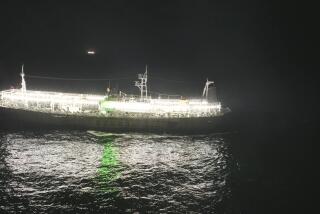Flow of Chinese Refugees Into U.S. Grows : Smuggling: Last week more than 500 would-be immigrants were found in ship’s holds. Since August, 1991, 1,126 nationals have been intercepted.
HONOLULU — When U.S. Coast Guardsmen boarded the freighter East Wood, drifting without power in the Pacific last week, they found more than 500 Chinese would-be immigrants who had survived five weeks stowed in cargo holds with no toilets and little sustenance.
The Coast Guard, which is now escorting the ship to the Marshall Islands, heard a strange tale from crew members. They said the ship had been hijacked by pirates who brought the illegal immigrants aboard after the East Wood left Hong Kong Dec. 27.
The East Wood’s generators failed 1,500 miles southwest of Honolulu and the vessel began to drift. The Coast Guard received a distress call on Jan. 30 from the radio operator, who said he feared for his life, claiming that pirates had commandeered the boat and loaded hundreds of Chinese passengers into the holds. He disappeared later that day, along with the second engineer. Crew members say they jumped or were forced overboard after a “fight with Chinese bad men.”
The Coast Guard discounts the tale, saying it has found evidence that the ship was prepared to handle human cargo before setting sail. But one thing is clear: The East Wood is the largest effort to smuggle undocumented Chinese into the United States in recent times.
A growing flow of refugees from the People’s Republic of China has tried to enter the United States, through Honolulu, Los Angeles, San Francisco and ports as far away as New Bedford, Mass. The first boat apprehended carried 131 Chinese passengers to Los Angeles in August, 1991. Since then, authorities have intercepted nine vessels, mostly trawlers, with a total of 1,126 Chinese nationals aboard. Honolulu has been the most popular destination.
The 310-foot East Wood, larger than any of the previous vessels, carries 527 Chinese nationals, more than three times as many as any previous load.
“If this is an indication of things to come, we’ve got a major problem on our hands,” said Rear Adm. William C. Donnell, district commander of the 14th Coast Guard District in Honolulu.
Verne Jervis, director of the press office for the U.S. Immigration and Naturalization Service, says authorities believe that another dozen boats may have arrived undetected. Smugglers demand up to $30,000 each from their passengers.
“It’s very difficult to deal with once they get here,” Jervis said. “People request asylum, and that’s a very long, involved procedure. We are fast running out of detention space.”
In their applications for refuge, previous arrivals have claimed some involvement in the Tian An Men Square uprising in Beijing or persecution based on China’s policy of limiting families to one child. Because Hawaii has no detention facilities, passengers apprehended here are sent to Terminal Island and El Centro, Calif., as well as detention centers elsewhere in the continental United States.
When the Coast Guard boarded the Panamanian-registered East Wood last week, it found no fresh water in the ship’s tanks and no safety equipment, but did uncover some stashes of food and bottled water. Food had been cooked either over open fires in the cargo holds or lowered by bucket from the main deck. Access to topside was limited.
“These people have been forced to defecate and urinate in the bilges or on the decking in these compartments,” reported Capt. Al Doty, commanding officer of the Coast Guard cutter Rush.
The passengers, who come from Fujian and Guangdong provinces in southeast China, broke into cheers and applause at the sight of the Coast Guard boarding party. The Rush’s crew quickly brought in freshly baked bread, rice and chicken, along with water and supplies to clean up the galley and holds.
More to Read
Sign up for Essential California
The most important California stories and recommendations in your inbox every morning.
You may occasionally receive promotional content from the Los Angeles Times.










